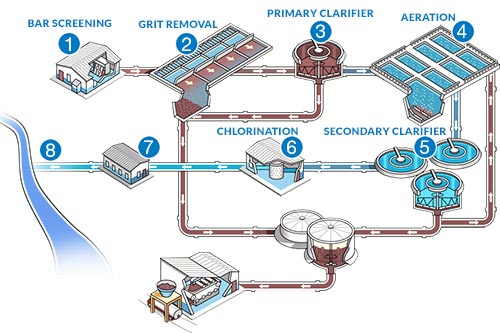How Wastewater Treatment Can Enhance Water Reuse Options
Wiki Article
Recognizing Wastewater Treatment Processes and Their Environmental Impact
The details of wastewater therapy procedures play an essential role in mitigating ecological difficulties related to water pollution. Each phase, from initial to advanced treatments, is developed to address specific impurities, inevitably guarding both public wellness and water environments. Nonetheless, regardless of technological improvements in therapy effectiveness, considerable difficulties persist, consisting of the management of residual contaminants and the ramifications of nutrient runoff. As we discover the intricacies of these processes, it comes to be important to doubt exactly how far existing methodologies can advance to satisfy the growing needs of sustainability and ecological conservation.Overview of Wastewater Therapy
Exactly how is wastewater changed into a secure resource for the setting? Wastewater therapy is a vital procedure made to remove pollutants from used water, thereby safeguarding public health and wellness and securing environments. This procedure begins with the collection of wastewater from household, commercial, and business resources, which is then directed to treatment facilities.At these facilities, various physical, chemical, and organic approaches are used to treat the wastewater. Subsequently, biological therapies, such as triggered sludge processes, utilize bacteria to damage down organic matter.
The dealt with effluent can be safely released right into natural water bodies or reused for irrigation and industrial purposes, promoting source preservation. In addition, the treatment procedure produces biosolids, which can be repurposed as plant foods or soil changes, further enhancing sustainability.
Stages of Treatment Processes
The wastewater therapy procedure commonly contains 3 key stages: preliminary, primary, and additional therapy. Each phase serves a distinctive role in lowering the contaminant lots and making sure the effluent fulfills environmental standards prior to discharge.
The main therapy phase concentrates on the physical splitting up of put on hold solids from the wastewater. Via sedimentation, heavier fragments settle at the bottom of sedimentation storage tanks, developing sludge, while lighter materials, such as oils and greases, float to the surface area and are skimmed. This procedure considerably lowers the natural and inorganic load in the wastewater.
Secondary therapy is a biological process targeted at further decreasing the focus of natural matter. Numerous methods, consisting of activated sludge systems and flowing filters, make use of microbes to metabolize natural toxins. This phase is vital for attaining the required biochemical oxygen demand (BOD) decrease, eventually causing cleaner effluent all set for discharge or further treatment. Each stage is critical in securing environmental and public wellness.

Advanced Therapy Technologies
Complying with the second treatment procedures, advanced treatment modern technologies play an important function in further improving the high quality of dealt with wastewater. These innovations are created to remove recurring impurities that are not efficiently removed throughout main and secondary therapies, ensuring the effluent fulfills strict regulative requirements.Amongst the commonly used advanced therapy approaches are membrane filtering, reverse osmosis, and progressed oxidation procedures. Membrane layer filtration, consisting of microfiltration and ultrafiltration, works in dividing great particles, virus, and colloids from the water (Wastewater). Reverse osmosis uses semi-permeable membranes to get rid of dissolved solids, leading to high-quality learn this here now water suitable for different applications
Advanced oxidation processes (AOPs) use solid oxidants to deteriorate natural pollutants, consisting of drugs and personal care products that are immune to standard treatment. These techniques enhance the biodegradability of complex substances, promoting their removal.
Another substantial innovation is using organic nutrient elimination processes, which especially target nitrogen and phosphorus, preventing eutrophication in receiving water bodies. Generally, advanced treatment modern technologies are necessary for accomplishing higher levels of purification, promoting water reuse, and securing public wellness while resolving the obstacles associated with wastewater administration.
Environmental Benefits of Therapy
Many environmental advantages arise from efficient wastewater treatment procedures that contribute to ecosystem health and sustainability. Largely, these processes considerably decrease the release of hazardous pollutants right into all-natural water bodies, which assists preserve aquatic environments. By getting rid of pollutants such as heavy steels, nutrients, and pathogens, dealt with wastewater reduces the danger of waterborne conditions and advertises biodiversity in aquatic atmospheres.Moreover, wastewater treatment facilities usually use sophisticated innovations that make it possible for water recycling and reuse. This practice not just preserves fresh water sources yet additionally minimizes the need on all-natural water products. Improved nutrient removal from wastewater can likewise stop eutrophication, a process that brings about algal flowers and succeeding oxygen deficiency in aquatic systems.
Furthermore, reliable treatment processes can reduce greenhouse gas emissions, especially methane and nitrous oxide, which are commonly released during without treatment wastewater decay. By recording and using biogas from anaerobic digesters, centers can transform waste right into renewable energy, thus adding to a decrease in nonrenewable fuel source reliance.
Obstacles and Future Trends
While the ecological advantages of wastewater therapy are clear, several challenges linger that prevent ideal results in this area. One major issue is aging facilities, which usually results in ineffectiveness and raised functional costs - Wastewater. Several treatment plants were developed decades back, and their capabilities do not align with modern needs, that include stricter governing criteria and greater quantities of wastewater because of urbanization
Looking ahead, there is an expanding emphasis on resource recuperation and round economic climate concepts within wastewater treatment. Developments such as anaerobic food digestion, which can generate biogas, and advanced filtering innovations are acquiring traction. These methods not just boost therapy efficiency yet additionally visit here advertise sustainability.
Ultimately, addressing these official statement obstacles calls for partnership among stakeholders, investment in innovation, and a dedication to recurring research study. By accepting these fads, the wastewater treatment market can advance to fulfill the needs of an altering atmosphere and culture.
Verdict
In conclusion, wastewater treatment processes play an essential role in enhancing environmental top quality and public wellness. The multi-stage therapy structure, paired with innovative technologies, effectively minimizes pollution and promotes sustainable water administration.Report this wiki page